|
(c)
Copyright Bartók Archives of the Hungarian Academy of Sciences
Institute for Musicology, 2004-2005
“Imaginary Folk Music”
|
| |
|
Out of [folk music], he
developed themes in the course of his works, mixing
peasant music and art music, even inventing
new motives of the same value, which Serge Moreux so
rightly calls “imaginary folk music.”
Louis Durey, “Hommage à Béla Bartók,” in
Béla Bartók, L’Homme et l’Oeuvre, special issue of La
Revue Musicale, no. 224 (1955), 10.
|
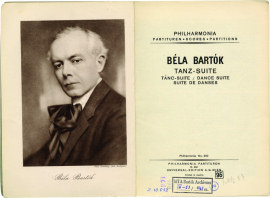 |
|
My Dance Suite on the program is one
of my most recent works; I composed it during the
summer. It comprises of five parts that follow one
another attacca, without a rest. All the five dances has
original, folk-like, but not real folksong, themes, and
between each dance I employed a brief ritornello, an
orchestral interlude, instead of a rest. ... The fifth
movement or dance is followed, again attacca, by some
kind of a finale in which all the themes previously
heard recur.
Bartók, “Tánc-suite” (Dance Suite,
1923), in Bartók Béla Írásai (Béla Bartók’s writings) 1,
ed. Tibor Tallián (Budapest, 1989), 66
|
| The aim of the whole work was to put
together a kind of idealized peasant music—you could
say an invented peasant music—in such a way that the
individual movements of the work should introduce
particular types of music.— Peasant music of all
nationalities served as a model: Magyar, Wallachian [=
Romanian], Slovak, and even Arabic. In fact, here and
there is even a hybrid from these species. Thus, for
example, the melody of the first subject of the first
movement is reminiscent of primitive Arabic peasant
music, whereas its rhythm is of East European folk music
... The ritornello theme is such a faithful imitation of
a certain kind of Hungarian folk melodies, that its
derivation might puzzle even the most knowledgeable
musical folklorist...
Bartók about the Dance Suite (from a
deleted passage of Bartók’s “Budapest” lecture of 1931);
translation in Tibor Tallián, Béla Bartók. The Man and His Work (Budapest,
1988), 133
|
|
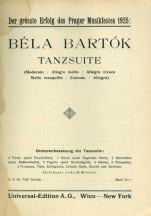
|
|
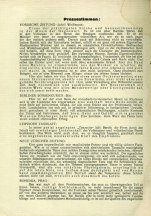
|
| |
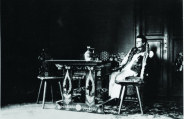
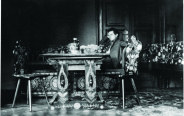
|
|

The question is, what are the ways in which peasant
music is taken over and becomes transmuted into modern
music?
We may, for
instance, take over a peasant melody unchanged or only
slightly varied, write an accompaniment to it and
possibly some opening and concluding phrases. This kind
of work would show a certain analogy with Bach’s
treatment of chorales. ...
Another
method... is the following: the composer does not make
use of a real peasant melody but invents his own
imitation of such melodies. There is no true difference
between this method and the one described above. ...
There is yet
a third way... Neither peasant melodies nor imitations
of peasant melodies can be found in his music, but it is
pervaded by the atmosphere of peasant music. In this
case we may say, he has completely absorbed the idiom of
peasant music which has become his musical mother
tongue.
Bartók, “The Influence of Peasant Music
on Modern Music” (1931), in Béla Bartók Essays, ed.
Benjamin Suchoff (London, 1976), 341–44
|
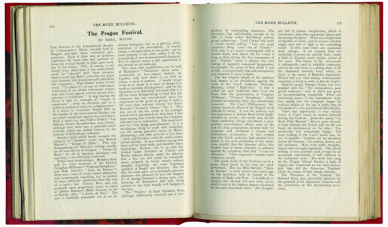 |
|
The good credit of the Festival
was to a great extent saved by the very last work
performed. This was Béla Bartók’s “Suite de Danses,” a
work written two years ago for the festivities held in
honour of the reunion of Buda and Pest. It is difficult
to imagine that Bartók will ever write music which is
not in the highest degree calculated for fine and
immediate effect. His thoughts are full of minute
complexities, which in conveyance take their appointed
places with disarming discipline. There are complexities
of rhythm, of colour, and of accent — yet how single and
full of light is the controlling mind! In this suite
there are occasional dark sayings; of set purpose they
are darkened, it seems, for quickly there comes a flash
to illumine every remote corner of the score. The theme
of the ritournelle is whimsically used to establish
continuity, and at the end there is a letting loose of
all the elemental barbaric force which, au fond, is the
source of Bartók’s inspiration. Where will you find
among contemporary musicians a mind so swift, so
fiercely bright?
Basil Maine, “The Prague Festival,” The Music
Bulletin 7, no. 6 (1925), 157
|
...Finally, the concert ends
with a real masterpiece, Béla Bartók’s Tanzsuite, music
full of imagination, rich in colours just like some
wonderful Magyar embroidery, music of formidable
technical skill but also of both sophisticated and
genuine dreamlike poesy. In recent years, I have rarely
experienced beauty of such strength and spiritual as
well as technical perfection.
Alfredo Casella, “Lettera da Praga,” Il Pianoforte 6,
no. 5 (1925), 195
 |
|
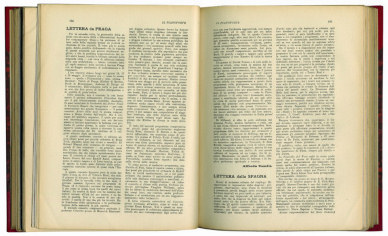 |
|
|
| |

|
|